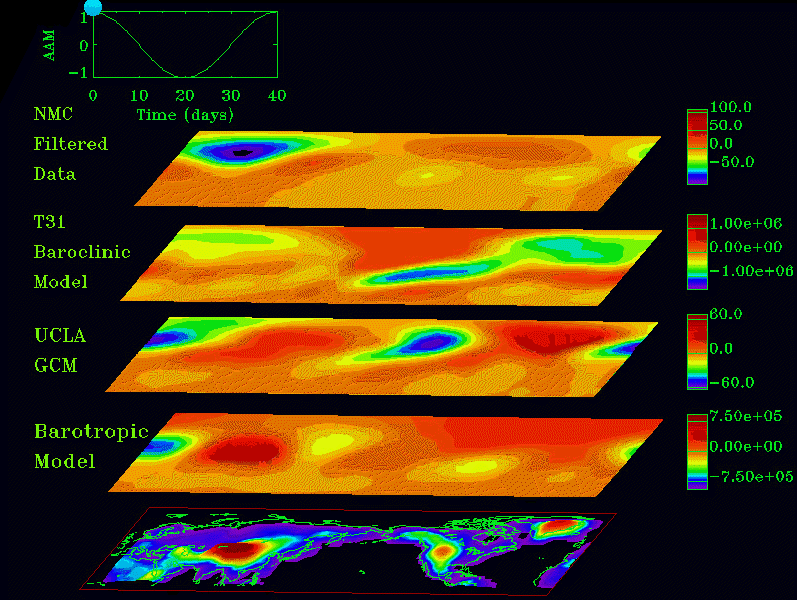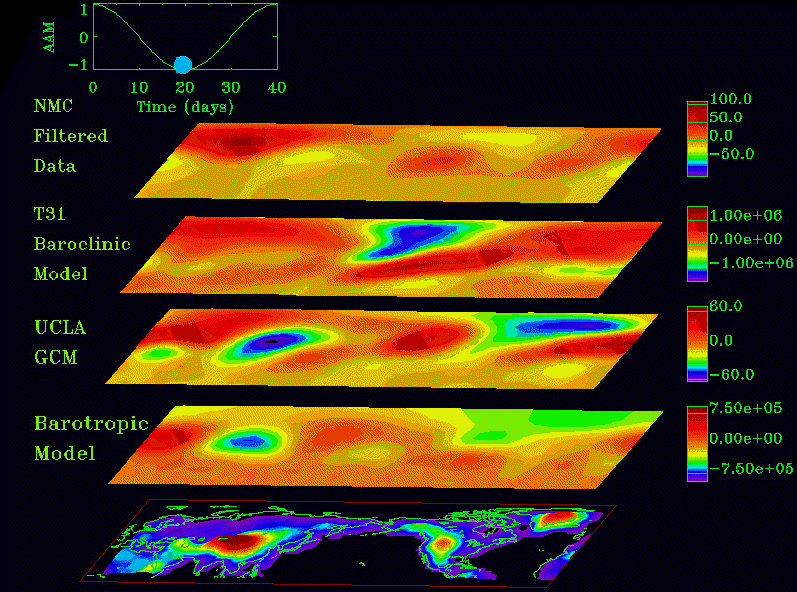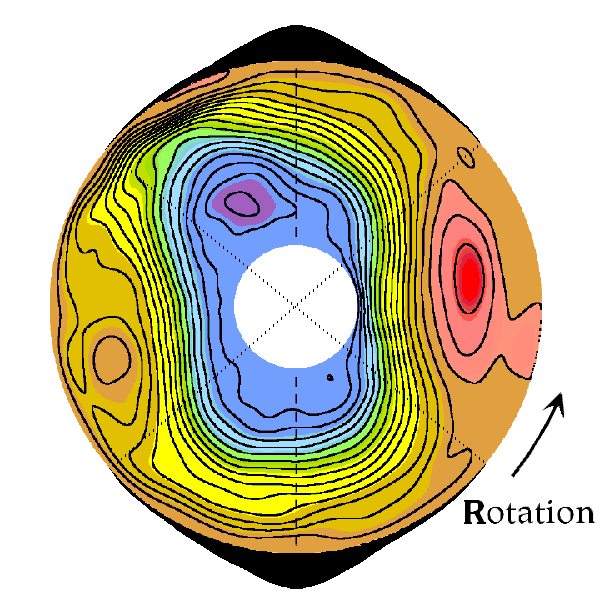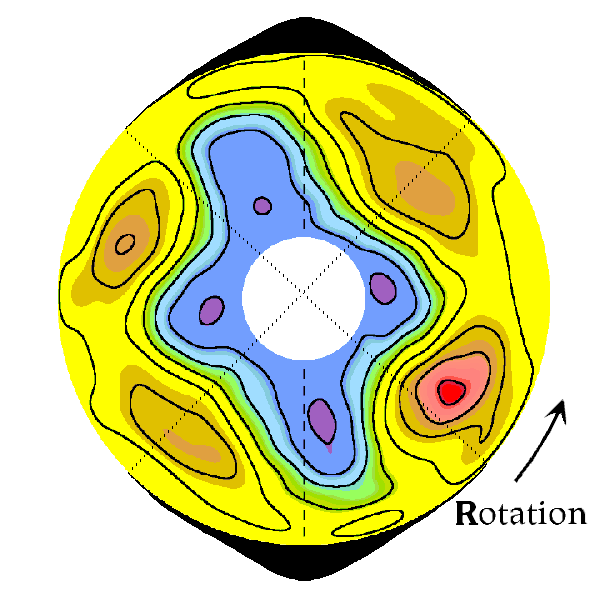
Understanding the low-frequency (f>1/10 days) variability (LFV) of
large-scale (L>10,000 km) atmospheric flows is essential
for extending the practical range of numerical weather prediction
beyond its theoretical limit (T~10 days).
The TCD group studies various aspects of this variability
via observations, laboratory experiments and hierarchical
numerical model studies, from the perspective of dynamical systems
theory, combined with statistical data analysis.
The atmosphere exchanges angular momentum with the solid
earth: as the winds speed up, the earth's rotation slows down, and
vice-versa. The two stacks show a comparison of the midlatitude
oscillation in angular momentum: i) in a 40- year data set, a barotropic,
one-layer, and a ii) baroclinic, 5-layer model, and iii) the UCLA General
Circulation Model. The period of the oscillation
shown on each deck is close to 40 days and arises from the interaction
of the meandering westerlies with the topography shown in the
lowermost deck.


The two lower (round) panels show the oscillation's same two
extreme phases of zonal and blocked flow [high and low atmospheric
angular momentum (AAM) or "index," as shown on the harmonic AAM clock
in the upper-left corner of either stack]. They are taken from an
experiment carried out in collaboration with
the team at University of Texas, Austin in the rapidly rotating
tank. Wavenumber-two topography (shown as a black rim around the
margin of the round panels) was introduced into the tank and the
experimental results are being compared with a
specially designed
numerical model.


Please see the
Department of Atmospheric Sciences brochure
(
Theoretical Climate Dynamics)
for other reserach areas in the low-frequency variability in
the atmopshere.
| TCD Members:
|
|
M. Ghil,
K. Ide, S. Kravtsov, A. Robertson. |
| References:
|
|
Bernardet, P., A. Butet, M. Déqué , M. Ghil and R. L. Pfeffer, 1990: Low-frequency oscillations in a rotating annulus with topography, J. Atmos. Sci., 47, 3023-3043.
|
|
Dickey, J. O., M. Ghil, and S. L. Marcus, 1991: Extratropical aspects of the 40-50 day oscillation in length-of-day and atmospheric angular momentum, J. Geophys. Res., 96, 22643-22658.
|
|
Ghil, M., 1987: Dynamics, statistics and predictability of planetary flow regimes, Irreversible Phenomena and Dynamical Systems Analysis in the Geosciences, C. Nicolis and G. Nicolis (Eds.), D. Reidel, Dordrecht/Boston/Lancaster, pp. 241-283.
|
|
Ghil, M., 1988: Nonlinear approaches to low-frequency atmospheric variability, Dynamics of Low-Frequency Phenomena in the Atmosphere, G. W. Branstator, R. A. Madden and J. J. Tribbia (Eds.), National Center for Atmospheric Research, Boulder, CO 80307, pp. 603-714; also in Proc. Summer School in Atmospheric Dynamics, Q.-C. Zeng (Ed.), Beijing, China, 1988.
|
|
Ghil, M., and S. Childress, 1987: Topics in Geophysical Fluid
Dynamics: Atmospheric Dynamics, Dynamo Theory and Climate Dynamics,
Springer-Verlag, New York/Berlin/London/Paris/ Tokyo, 485 pp.
|
|
Ghil, M., R. Benzi and G. Parisi (Eds.), l985: Turbulence and
Predictability in Geophysical Fluid Dynamics and Climate Dynamics,
North-Holland Publ. Co., Amsterdam/New York/Oxford/ Tokyo, 449 pp.
|
|
Ghil, M., M. Kimoto, and J. D. Neelin, 1991: Nonlinear dynamics and
predictability in the atmospheric sciences, Rev. Geophys.,
Supplement (U.S. Nat'l Rept. to Int'l Union of Geodesy & Geophys.
1987-1990), 36, 46-55.
|
|
Jin, F-f., and M. Ghil, 1990: Intraseasonal oscillations in the extratropics: Hopf bifurcation and topographic instabilities, J. Atmos. Sci., 47, 3007-3022.
|
|
Kimoto, M., and M. Ghil, 1993a: Multiple flow regimes in the Northern
Hemisphere winter. Part I: Methodology and hemispheric regimes, J.
Atmos. Sci., 50, 2625-2643.
|
|
Kimoto, M., and M. Ghil, 1993b: Multiple flow regimes in the Northern
Hemisphere winter. Part II: Sectorial regimes and preferred transitions,
J. Atmos. Sci., 50, 2645-2673.
|
|
Legras, B., and M. Ghil, l985: Persistent anomalies, blocking and variations in atmospheric predictability, J. Atmos. Sci., 42, 433-47l.
|
|
Marcus, S. L., M. Ghil and J. O. Dickey, 1994: The extratropical
40-day oscillation in the UCLA general circulation model. Part I:
Atmospheric angular momentum, J. Atmos. Sci., 51,
1431-1446.
|
|
Marcus, S. L., M. Ghil and J. O. Dickey, 1996: The extratropical 40-day oscillation
in the UCLA general circulation model. Part II: Spatial structure, J. Atmos.
Sci., 53, 1993-2014.
|
|
Mo, K., and M. Ghil, 1987: Statistics and dynamics of persistent anomalies, J. Atmos. Sci., 44, 877-901.
|
|
Mo, K., and M. Ghil, 1988: Cluster analysis of multiple planetary flow regimes, J. Geophys. Res., 93D, 10927-10952.
|
|
Strong, C. M., F.-f. Jin and M. Ghil, 1993: Intraseasonal variability
in a barotropic model with seasonal forcing, J. Atmos. Sci.,
50, 2965-2986.
|
|
Strong, C. M., F.-f. Jin and M. Ghil, 1995: Intraseasonal
oscillations in a barotropic model with annual cycle, and their
predictability, J. Atmos. Sci., 52, 2627-2642.
|
|
Weeks, E. R., Y. Tian, J. S. Urbach, K. Ide, H. L. Swinne
y, and M. Ghil, 1997: Transitions between blocked and zonal flows in a rotating
annulus with topography. Science, 278, 1598-1601.
|
Last modified: 3/1/03






